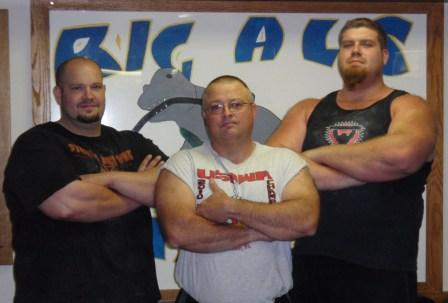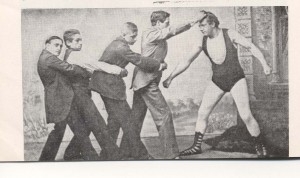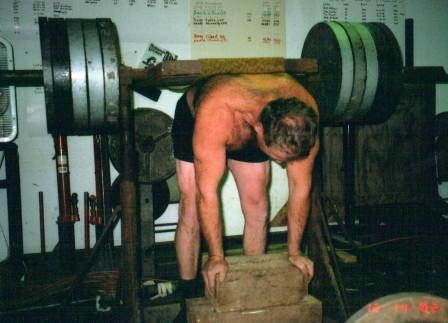JWC Straight Weight Postal
Heavyweights Battle it out in Postal Challenge
By Thom Van Vleck

Team Dino Gym wins the Straight Weight Postal Challenge. Pictured from left to right: Scott Tully, Al Myers, and John Conner
Two teams participated in the challenge and the Dino Gym pulled out the victory. This meet was a new concept for a USAWA meet and we will see if it catches on. The idea being there would be no formulas used, the winners decided on who lifted the most weight…period. I proposed the idea of the “straight weight” meet to get some of the bigger guys to come out and participate and as a result, some big boys showed up. The Dino Gym had a combined weight that was a “Big Al Bacon n’Eggs style breakfast” short of a half ton at 991lbs. The JWC was a relatively svelte 915lbs. The average weight of the lifters involved was 318lbs! I can only guess what that weight would have been had Al not had to replace his original team member, Mark Mitchell, who had to withdraw with a back injury! Al’s paltry 255lbs brought the average way down!!!
I hope this meet was taken as intended: Just another alternative and one that the Big Boy’s could embrace as their own. I know my guys had fun doing it and hopefully it will motivate them to do some more USAWA lifting! Oh, and one more thing, I calculated the age and weight factors just to see the outcome….and the Dino Gym doesn’t want to know those results!
Full Meet Results:
Officials for Dino Gym Team: Al Myers and Scott Tully
Official for JWC: Thom Van Vleck
Dino Gym Team: Al Myers (44 yrs, 255lbs), Scott Tully (34 yrs, 344lbs) John Conner (25 yrs, 392lbs)
Jackson Weightlifting Club: Thom Van Vleck (46yrs, 295lbs), John O’Brien (42 years, 285lbs), Josh Hettinger (29yrs, 335lbs)
Push Press – From Rack
- John Conner 380lbs
- Josh Hettinger 335lbs
- John O’Brien 300lbs, Scott Tully 300lbs, Al Myers 300lbs
- Thom Van Vleck 255lbs
DG: 980lbs & JWC: 890lbs
Vertical Bar Deadlift – 2 bars, 1″
- John Conner 500lbs
- Scott Tully 420lbs
- Josh Hettinger 400lbs, Al Myers 400lbs
- John O’Brien 380lbs
- Thom Van Vleck 280lbs
DG: 1320lbs & JWC: 1060lbs
Continental to Chest
- John Conner 385lbs
- John O’Brien 335lbs
- Al Myers 325lbs, Scott Tully 325lbs
- Thom Van Vleck 315lbs
- Josh Hettinger 275lbs
DG: 1085lbs & JWC: 925lbs
Cheat Curl
- John Conner 250lbs
- John O’Brien 235lbs
- Thom Van Vleck 215lbs, Josh Hettinger 215lbs
- Al Myers 201lbs
- Scott Tully 181lbs
JWC: 665lbs & DG: 632lbs
Shoulder Drop
- John O’Brien 95lbs, Josh Hettinger 95lb
- Thom Van Vleck 85lbs
- John Conner 45lbs, Al Myers 45lbs
- Scott Tully 30lbs
JWC: 275lbs & DG: 120lbs
Totals: 1st Place: Dino Gym 4087lbs, 2nd Place: JWC 3835lbs

